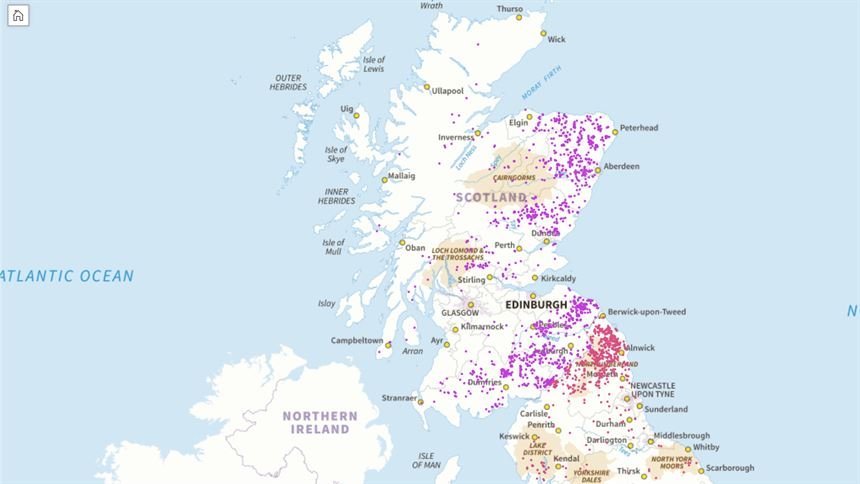How the Lake District is re-building in the New Year
As the New Year begins in the Lake District, reminisce of the damage caused by Storm Arwen still remains. Yet, as we have done many times before, local communities along with the national park authority are working hard on restoration projects.
In late November last year, Storm Arwen swept through the UK causing two days of destruction. Rain, snow and high winds of nearly 100mph hit areas of Cumbria hard, damaging local roads, woodland, homes and businesses. The last time Lakeland was damaged to this extent was likely back in 2015 when Storm Desmond hit.
Yet, despite the damage, the Lake District always bounces back with help from amazing people including national park rangers, volunteers and local businesses.
Two months on from the storm, we have a look at how restoration work is getting on, focusing on the positive outcomes for 2022…
Work is on the way to restore Lake District woodland
In December, an on-going campaign was launched to help recover woodlands following the extensive damage caused by Storm Arwen. Thousands of trees were felled across the national park, but particularly badly affected areas included Orrest Head and Elleray Woods in Windermere, which suffered the loss of over 75 felled trees, Thirlmere woodland, which lost over 1,500 trees and the Coniston area with hundreds of trees uprooted at Tarn Hows.
The Lake District Foundation’s Real Hedge Fund turned its attention on planting new trees and hedges that were lost in the storm. The campaign relies heavily on charity donations, with every £25 donated helping to create one metre of bio-diverse hedgerow or the re-planting of up to five saplings.
Sarah Swindley, CEO of the Lake District Foundation, said: “You only have to walk around the county to see the scale of destruction to our woodlands following Storm Arwen. Our existing Real Hedge Fund campaign has been helping to restore Cumbria’s hedgerows. Given the impact of Storm Arwen we are now extending that campaign to include replanting of trees felled by the storm.”
The National Trust rangers and forestry team have also claimed they are facing an ‘emotional’ job clearing the damage. The charity are reaching out to the public to donate to their ‘Woodlands Appeal’ to assist with restoration work to areas including Tarn Hows. A once beloved place of famous local author Beatrix Potter, Tarn Hows devastatingly suffered from the storm, with fallen trees and debris blocking access roads and footpaths, making the area difficult to reach for restoration workers and unsafe for visitors.
Andy Jasper, Head of Gardens and Parklands at the National Trust, said: “Our gardens and landscapes will take months to clear up and years, even decades to fully restore. Some won’t be the same again but I have no doubt that our amazing teams will recreate these much-loved places and reopen them for everyone to enjoy.”
Footpaths are now re-opening
The destruction of woodland across the lakes meant a lot of major footpaths were blocked or affected. Although restoration work is still underway in some areas, major improvements have already been made with a number of major footpaths now re-opened including…
Keswick to Threlkeld
The Keswick to Threlkeld footpath, which follows the old railway route, was damaged in over several areas during Storm Arwen. This was a particular emotional hit to the national park due to the extensive improvements that were already being made prior to Storm Arwen following damage (including the destruction of two bridges on the trail) from Storm Desmond in 2015.
The fully refurbished trail, following over five years of restoration work as a result of Storm Desmond, was officially opened in December 2020 by Richard Leafe, CEO of the Lake District National Park and Paul Titley, Mayor of Keswick cutting the ribbon.
A spokesperson for the Lake District National Park Authority claimed they were ‘delighted’ that the footpath has now re-opened once again following Storm Arwen, stating: “National park rangers and contractors worked to clear fallen trees, debris, loose trees and vegetation off the cuttings and small tunnel entrance. Some very large root balls of trees that had fallen into the tunnel mouth were removed and fencing was repaired.”
Elleray Wood
After a six-week closure due to fallen trees and broken branches posing a danger to the public, the footpath in Elleray Wood has now reopened. The popular footpath is a gateway to Windermere’s famous viewpoint at Orrest Head and is a much-loved walk for both locals and tourists.
Councillor Adrian Legge, Mayor of Windermere and Bowness is delighted the trail is back open but is still urging walkers to take caution when visiting the woods and stick to the restored footpaths as it will take months to remove other hanging trees from all parts of the woodland.
Grizedale Forest Park
Grizedale Forest has been able to partially re-open some of the woodlands main walking trails following restoration work. Accessible routes include the Ridding Wood Walking Trail, the Grizedale Tarn Walking Trail, the forest play area and roads on the east side of the forest. The café and visitor centre has also re-opened following electrical issues with their phone lines.
Unfortunately, some areas of the woodland remain closed requiring further work, including the west side of the forest, the Millwood Trail, Bogle Crag walking trail, Gruffalo Spotters Trail, North Face & Black bike trial and the sites Go Ape centre. Unfortunately, for the time being, many footpaths across the lakes are still closed as a result of storm damage and undergoing work. Here is a list of some areas to avoid for now…
Belle Grange
The byway between Strawberry Gardens and Belle Grange near Ambleside is still inaccessible due to fallen trees. Work is underway removing the trees and clearing the pathway, however dangers from surrounded overhanging and weakened trees still pose a risk.
Blea Tarn Woodland Path
Footpaths through the woodland beside Blea Tarn are currently inaccessible due to fallen trees blocking paths and posing a risk to hikers.
Whinlatter Forest Footpath to Barf
Although a lot of routes in Whinlatter forest are open, some areas have been affected including the forest path to the mountain Barf, which is closed due to storm damage.
Sections of Thirlmere
Thirlmere’s West Road, which runs alongside the reservoir, remains blocked, with repairs following the storm still underway. Some sections of the road and footpaths are estimated to be closed until 2023. Landowners, Untied Utilities said due to the scale of the damage, the water company have planned four phases of work before all paths and roads in the area can re-open.
Cumbria Woodland
When planning a walk, double check your chosen route is safe and open before you head off. Using earth observation data, Forest Research has created a map following Storm Arwen, to identify areas with windblown trees, which may pose a risk.
Re-building
Affected businesses and attractions are currently re-building
Not only did the impact of the storm damage precious woodland, local businesses and attractions also suffered due to electrical faults and damage to buildings and surroundings. Businesses in Windermere were hit particularly hard with the shoreline being one of the worst affected areas in the Lake District.
Wray Castle on the shores of Windermere suffered irreplaceable damage losing a beech tree on the castle grounds, which was the biggest of its species in the UK and Ireland, along with original trees planted in the 1840’s by the Dawson’s as they were building the castle. Sections of the main castle building suffered minor damage but the biggest loss was to the castle grounds and parkland.
Grace Olsen, Senior Marketing and Communications Officer at Wray Castle told us the effects have been personally devastating but positive work is underway to restore the castle and grounds, including the re-planting of special trees.
“The biggest impact has been on the trees in the grounds and the castle’s arboretum,” said Grace. “In the arboretum, we lost a variety of trees including champion beech. We’re working on getting them cleared as soon as possible so visitors can walk through again and see the wonderful specimens of cedar that remain. We also plan on planting new trees to replace the special ones we lost.”
Woodland areas surrounding Keswick also suffered sustainable damage, forcing local family business Keswick Climbing Wall & Outdoor Activity Centre to close their outdoor site in Rookery Woods.
Jack Beament, assistant manager at the centre explained the damage was widespread across the land, with fallen trees going right through the middle of the main elements in the woodland area, damaging the sites popular play park.
“It’s awful, absolutely awful because this sort of stuff doesn’t get built overnight,” said Jack. “It’s months and months and months of work just to see it get destroyed overnight. Especially for family business like ours it really hits hard because you go to bed at night wondering if the main part of your business is going to be open in the morning.”
The centre is open for indoor climbing, archery and outdoor activities too.
Unfortunately, Rookery Woods still remains closed for now, but the team are staying positive and working extremely hard to bring some new elements to the woodland, with the centre on track to re-open the woods by February Half Term.

























